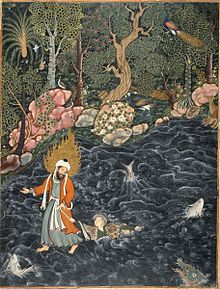Akbar Hamzanama

The Akbar Hamzanama (also known as Akbar's Hamzanama) is an enormous illustrated manuscript, now fragmentary, of the Persian epic
Origins
Though the first Mughal Emperor,
Paintings
Apart from the text, the manuscript included 1400 full-page
The size of the commission was completely unprecedented, and stretched even the huge imperial workshop. According to contemporary accounts, about thirty main artists were used, and over a hundred men worked on the various aspects of the book in all. According to Badauni and Shahnawaz Khan the work of preparing the illustrations was supervised initially by Mir Sayyid Ali and subsequently by Abdus Samad, the former possibly being replaced as head of the workshop because the pace of production was too slow. After seven years only four volumes were completed, but the new head was able to galvanize production and complete the ten volumes in another seven years, without any loss of quality. Indeed, "the later pages are the most exciting and innovative in the work".[4]
The
Libraries and exhibitions
At some fairly early point, the manuscript became dispersed, and only a little over a hundred of the paintings survive.
Holdings of pages of the manuscript include:
- 61 in the Museum of Applied Arts, Vienna, acquired from the Persian government on the occasion of the 1873 Vienna World's Fair.[10]
- 27 in the Victoria and Albert Museum, London, acquired from a shop in Kashmir in 1896 by Sir Caspar Purdon Clarke, a curator at the Museum.[11]
- 5 in the Metropolitan Museum of Art in New York, acquired through three purchases around the beginning of the twentieth century.[12]
- 4 in the Brooklyn Museum (24.46-49)[13]
- 3 in the Ashmolean Museum in Oxford, on loan from Howard Hodgkin, one of which he acquired from Maria Sarre-Humann (LI118.1,2 & 100).[14]
- Prince Qasim and the Champions of Iran and Turan, in the Los Angeles County Museum of Art (M.78.9.1), acquired in 1978 from the Nasli and Alice Heeramaneck Collection.[15]
- The Battle of Mazandaran, in the Washington D.C.[16]
- The Prophet Elijah rescuing the nephew of Hamza, in the British Museum (ME OA 1925.9-29.01)[17][18]
- Hamza burns the chest of Zarthust, in the David Collection in Chicago Art Institute in 1998.[19]
- Four men in combat, in the Fralin Museum of Art (1999.19) since 1999.[20]
- Qasam al-Abbas arrives from Mecca and crushes Tahmâsp with a mace, in the Philadelphia Museum of Art since 1937, acquired from the Brooklyn Museum (1937-4-1).[21]
- Khwaja Umar escaping from the Murzuq camp, since 2004 at the Museum of Islamic Art, Doha (Ms.31.2004).[22]
- 2 paintings in the Museum of Fine Arts, Boston (06.129 & 24.129).[23]
- 1 painting in the National Gallery of Victoria in Melbourne (AS12-1978), since 1978.[24][25]
- 1 painting in the Khalili Collection of Islamic Art.[7][26]
Example images
-
text on averso(battle of Mazandaran)
-
Umar, disguised as Mazmahil the Surgeon, practices quackery on the Sorcerers of Antali, c. 1570.[27]
-
Mihrdukht shoots an arrow through the ring
References
- ^ Beach, 60
- ^ H. Blochmann, trans., Ain-i Akbari (Lahore: Qausain, 1975; 2nd ed.), p. 115.
- ^ Stuart Cary Welch, Imperial Mughal Painting (Braziller, 1978), p. 44.
- ^ a b Beach, 61
- ^ Grove
- ^ Titley, 189; Titley says "only just over one hundred of the paintings have survived", while the V&A says "about 140", but they are counting fragments.
- ^ ISSN 1543-950X.
- ^ exhibition GLOBAL:LAB, 03.06.2009 - 27.09.2009 Archived 2010-12-29 at the Wayback Machine at the MAK Vienna.
- ^ V&A Archived 2008-06-24 at the Wayback Machine
- ^ (in German) Hamzanama.
- ^ Catalogue record at the V&A.
- ^ Catalogue record at the Met.
- ^ Catalogue record at the Brooklyn Museum.
- ^ Catalogue record at the Ashmolean.
- ^ Catalogue record at LACMA.
- ^ Catalogue record at Library of Congress.
- ^ Catalogue record at the BM.
- ^ "British Museum - the prophet Elijah rescuing Hamza's nephew, Prince Nur ad-Dahr, a painting in gouache on cotton". Archived from the original on 2015-10-18. Retrieved 2017-06-24.
- ^ Catalogue record.
- ^ Catalogue record at the Fralin Archived 2014-04-07 at the Wayback Machine.
- ^ Catalogue record at the Philadelphia Museum of Art.
- ^ Catalogue record at the MIA Archived 2014-04-07 at the Wayback Machine.
- ^ Catalogue record at MFA Boston.
- ^ Catalogue record at NGV.
- ^ Google Art page.
- ^ "Paintings from India". Khalili Collections. Retrieved 2023-03-29.
- ^ This painting of the "Qissa" (Accession no. 24.49) is identified as Book 11, 84 r. by Sheila Canby and is one of a series of three that depict the entry of Amr and his companions into the fort of Zumurud Shah and his sorcerers disguised as a physician and his attendant.
Sources
- Beach, Milo Cleveland, Early Mughal painting, Harvard University Press, 1987, ISBN 978-0-674-22185-7
- "Grove", Oxford Art Online, "Indian sub., §VI, 4(i): Mughal ptg styles, 16th–19th centuries", restricted access.
- Titley, Norah M., Persian Miniature Painting, and its Influence on the Art of Turkey and India, 1983, University of Texas Press, 0292764847
Further reading
- Heinrich Glück, Die indischen Miniaturen des Haemzae-Romanes im Österreichischen Museum für Kunst und Industrie in Wien und in anderen Sammlungen. Mit einer Wiederherstellung des Romantextes., Vienna, Amalthea-Verlag, 1925, 155 p.
- Seyller, John, The Adventures of Hamza – Painting and storytelling in Mughal India, Freer Gallery and Azimuth edition, London, 2002, 320 p. ISBN 1-898592-23-3
- Hamza-nama: Vollständige Wiedergabe der bekannten Blätter der Handschrift aus den Beständen aller erreichbaren Sammlungen. Graz: Akademische Druck-u.Verlagsanstalt, 1982
External links
- "The arts of the Mughal Empire", V&A exhibition webpage
- "The Adventures of Hamza, June 2002 - October 2003", MAK exhibition webpage



![Umar, disguised as Mazmahil the Surgeon, practices quackery on the Sorcerers of Antali, c. 1570.[27]](http://upload.wikimedia.org/wikipedia/commons/thumb/e/e5/Brooklyn_Museum_-_Amr_Disguised_as_Mazmahil_the_Surgeon_Practices_Quackery_on_the_Sorcerers_of_Antali.jpg/220px-Brooklyn_Museum_-_Amr_Disguised_as_Mazmahil_the_Surgeon_Practices_Quackery_on_the_Sorcerers_of_Antali.jpg)
